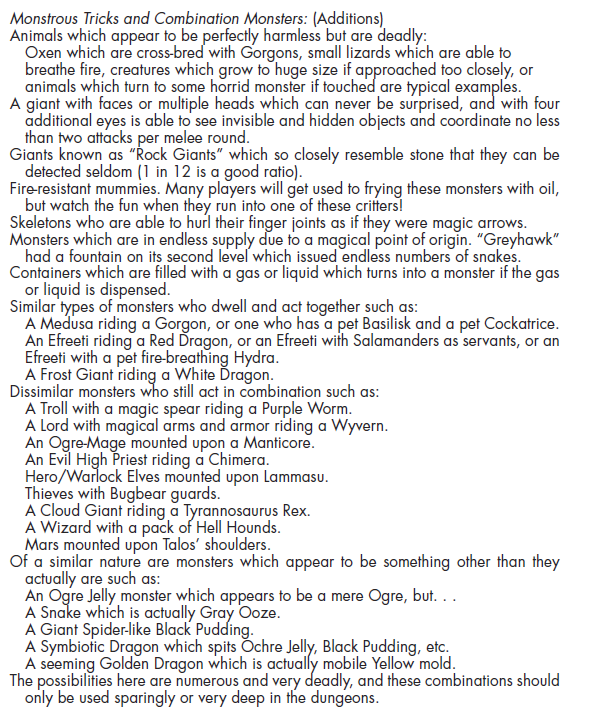A friend recently asked "How do you make dungeon crawls work? My group always finds them so boring."
I& #39;ve been giving this some thought, and I reckon there has been a couple of trends in D&D that have undercut the classic dungeon crawl. [thread]
#dnd #ttrpg
I& #39;ve been giving this some thought, and I reckon there has been a couple of trends in D&D that have undercut the classic dungeon crawl. [thread]
#dnd #ttrpg
The very earliest D&D dungeon designs (the stuff Gygax and Arneson were doing in the early 70s) were mazes that made little architectural sense. They were designed to confuse the players and get them lost.
In the same way, encounters within the dungeon were decidedly "gonzo". The emphasis was on the weird and wild, rather than creating a cohesive ecosystem. Imagination was king and verisimilitude was not really in the design dictionary.
As an example of this, here& #39;s an excerpt from a table of "Monstrous" tricks, included in Greyhawk (original edition). It gives you a good sense of the expected flavor of dungeons:
As has often been commented, there was often no overarching story in these original dungeons. Although this aspect can be overblown. There were often little stories attached to each encounter. But the idea was that a story emerged as the characters played.
This all changed in the 1980s. Old school grognards even have a date for this change - 1982 when Tracy & Laura Hickman published I3 Pharoah. A few quiet corners of the net even call this the "Hickman Revolution".
The emphasis now was on an overarching, cohesive plot, usually with epic overtones. Dungeons were not silly little mazes, but structures that made sense architecturally. And encounters had to make sense within the overall plot.
This style of play was enormously popular.
This style of play was enormously popular.
There was a new emphasis on realism and verisimilitude. Gone was the gonzo. Gone were the silly encounters and silly mazes.
And this proved a problem. While the Hickmans often managed to combine the best of the "old old school" with their emphasis on "realism," others failed
And this proved a problem. While the Hickmans often managed to combine the best of the "old old school" with their emphasis on "realism," others failed
Many, many dungeons written since that time became decidedly "mundane." They were realistic but lacked the sense of the fantastic. You no longer found a box of animal crackers that turned into monsters because that makes no friggin sense.
Dungeon architecture became more straightforward - because that makes sense - but also more tedious. When my friend said he found dungeons crawls dull, the fault was not with him and his group. It is because modern dungeons often are dull.
Can we turn back the clock and have dungeons filled with marvelous nonsense? Well, @warfteiner and I wrote a nonsensical dungeon called "Blue Alley" (an update of @TheEdVerse& #39;s original) and it has been one of the most popular short 5e adventures ever.
However...
However...
The premise behind it (wizard created a funhouse dungeon) can only get so many runs. Modern audiences do want things to make a bit more sense, and get a bit frustrated when they don& #39;t. We can& #39;t turn the clock back to 1974.
What can we do? I think there is much, much, much more room to inject "the fantastic" into our dungeons. Far too often, we settle for the mundane when we could choose the marvelous instead.
My last couple of dungeons, I& #39;ve tried very hard to do this, often by putting in things that the DMG Appendix A calls "tricks." Little interactive elements that have strange and unexpected results.
And yes, I lean heavily on random tables when trying to conjure up these "gonzo" elements. The most memorable encounter in "Eye of Klothys" came from this set of randomly generated words "flower mandala, moon orb".
These adventures have been well-received, so I& #39;m continuing to refine the method. And, so far at least, no-one has told me they are boring...
finis
finis

 Read on Twitter
Read on Twitter![A friend recently asked "How do you make dungeon crawls work? My group always finds them so boring."I& #39;ve been giving this some thought, and I reckon there has been a couple of trends in D&D that have undercut the classic dungeon crawl. [thread] #dnd #ttrpg A friend recently asked "How do you make dungeon crawls work? My group always finds them so boring."I& #39;ve been giving this some thought, and I reckon there has been a couple of trends in D&D that have undercut the classic dungeon crawl. [thread] #dnd #ttrpg](https://pbs.twimg.com/media/EgDiPONUEAAm6LB.png)



